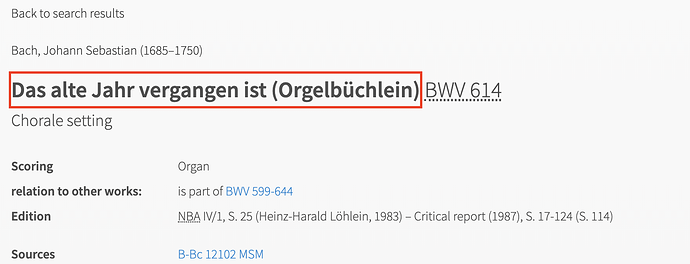There are inconsistencies in how J.S. Bach works are named.
Some of his works are named using collection titles, or descriptive words (type of work):
for example:
Choralvorspiel, BWV 614 “Das alte Jahr vergangen ist”
while others are using only the work title followed by the BWV reference:
Nun freut euch, lieben Christen g’mein, BWV 734
(This is also an organ choral, exactly the same type of work)
This lead me to wonder what should be the naming rule for Bach works, which is typically difficult, as they have been named differently in different publications.
The authoritative source of J.S. Bach is usually considered the BWV catalog.
This lead me to consider that the “canonical” name of a work should be the name/title of the work in this catalog.
The naming of a J.S. Bach work would therefore be:
Title of the work in BWV catalog", BWV ### (number of the work in the catalog)
This naming would be in line with the second example, and a large number of names already given.
This approach raises the question of where to find this information from the BWV catalog.
There are a number of sources with copies of the catalog listing:
These different sources may have minor differences or errors, or include comments from editors of these sources.
This lead me to use what seems to be the most reliable and up to date source on J.S. Bach works: Bach Digital database.
This database is professionally curated and updated with the latest updates from research on J.S. Bach works. It provides an easy to use source for “canonical” information on J.S. Bach works.
My suggestion would be to use this as “golden source” for canonical names of J.S Bach.
Each entry in this database is consistently structured, with the “Uniform title” followed by the BWV reference. This seems to me as a good source for canonical names of J.S Bach works.
So my first approach would be corrected as follows:
The naming of a J.S. Bach work would therefore be:
Uniform title from Digital Bach database", BWV ### (number of the work in the BWV catalog)
in this example:
Das alte Jahr vergangen ist (Orgelbüchlein), BWV 614
